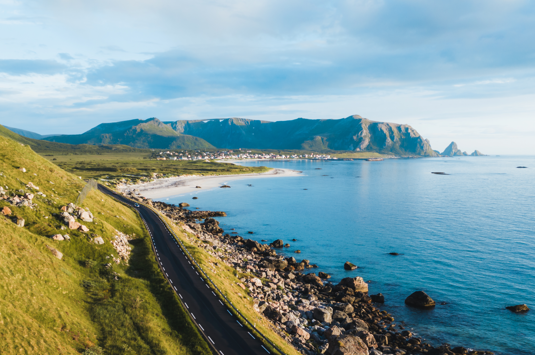
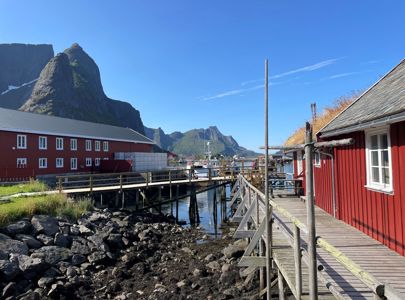

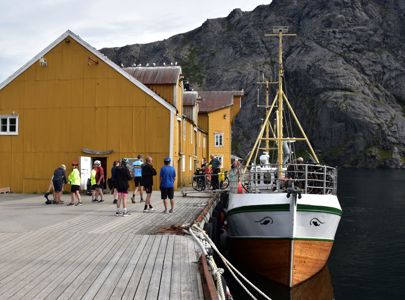
Cycling Through the Lofoten Islands
Luggage transfer
Midnight sun/Northern Lights
Spectacular scenery
Picturesque fishing villages
Cultural experiences
7 x accommodation | 7 x breakfast | 7 x self-packed lunch | 3 x dinner | Bicycle ferry | Luggage transfer | Tour description | Digital maps | GPX files
This tour must be booked no later than 60 days prior to departure.
Cycling through the Lofoten Islands is a once-in-a-lifetime experience, where you connect to the dramatic landscape that changes with the light. As you cycle, we encourage you to combine natural and cultural experiences.
With the Midnight Sun from June to mid-July, and the Northern Lights visible from late August this place will amaze you in any season. Along the way you can stop to savor local delicacies, and traditional dishes from Lofoten. Explore old churches, museums that provide insights into Lofoten` s history and culture, or go fishing, hiking, or kayaking.
This unforgettable bike ride starts in Svolvær, where you will be greeted by boats resting on the calm water of the harbor, surrounded by majestic mountains. As you pedal onwards, Lofoten’ s wild beauty unfolds before you.The charming fishing village Henningsvær, nestled on a cluster of islets with a backdrop of mountains, is a must-see place. Staying at Lofoten Links Lodges, nestled amidst rugged mountains and white sandy beaches in Hov, the lodges provide stunning views of the midnight sun and the ocean. You can enjoy playing golf at the world-class Lofoten Links course nearby.
The cultural gem Nusfjord offers a glimpse into Norway`s maritime heritage amidst a stunning natural setting.
The route leads you through lush meadows, where sheep graze in the green grass and rivers wind through the scenery. You`ll pass by small farms and courtyards that provide a glimpse into the everyday life of the locals in this rugged environment. Enjoy the fresh sea breeze as you cycle past small fishing huts and pristine white beaches that seem lost in time. The tour ends in beautiful Reine, surrounded by pointy peaks, fjords, and the traditional fishermen`s cabins.
Please note that Lofoten is a very popular place for a short while during the summer months, with few hotels. Some traffic must be expected, and varied accommodation is offered. In the high season you must be prepared to share the main road with many buses and campervans.
For an alternative, with less traffic and crowds, we recommend Round trip in Vesterålen
Part of the tour follows the Norwegian Scenic Route Lofoten.
This tour can be combined with the Arctic Coast cycling tour.
Discover Norway with a multi-day cycling tour in the Lofoten Islands!
See more cycling vacations here
Useful information
Facts about Norway
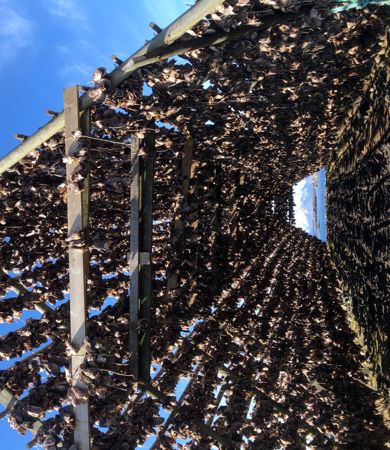
Dried fish has a long-standing tradition and is considered an important part of our cultural heritage in Norway. Fish flakes are used to preserve unsalted fish in Lofoten and other places along the coast of Northern Norway. Here, the fish hangs on the flakes from February to May and dries naturally in the sun and wind. Snow protects against insects and prevents bacteria growth. When the fish is dried, it can be stored for a long time and used as food throughout the year. It is also easier to transport to the marked when dried.
Luggage transfer
Midnight sun/Northern Lights
Spectacular scenery
Picturesque fishing villages
Cultural experiences
7 x accommodation | 7 x breakfast | 7 x self-packed lunch | 3 x dinner | Bicycle ferry | Luggage transfer | Tour description | Digital maps | GPX files
This tour must be booked no later than 60 days prior to departure.
-
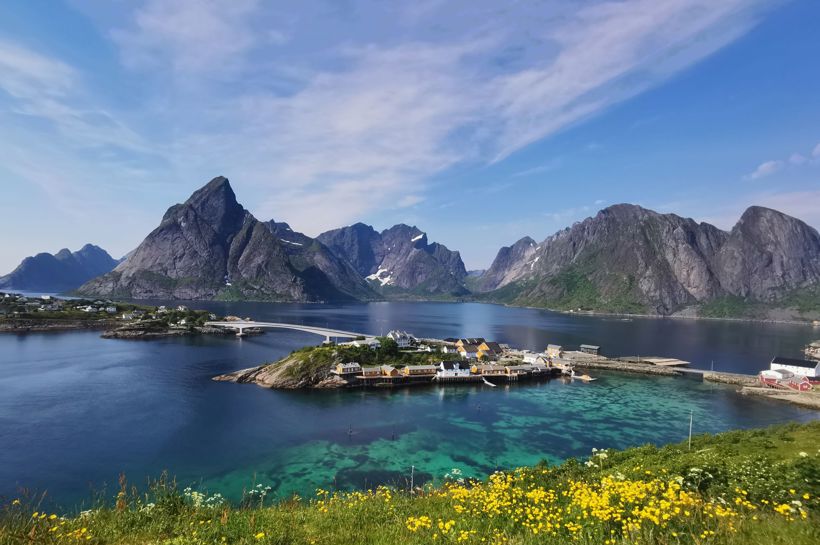 Photo: Elisa Sanderud - Lofoten Bed & Bike
Photo: Elisa Sanderud - Lofoten Bed & Bike
Number of participants:
2 - 16 people on each departure
Price per person 2025:
NOK 25,000.- in a doubleroom
Single room supplement:
NOK 9,950.-
Extra:
Topographic map: NOK 350.-
Bike rental 7 days, including return transfer from Reine:
Touring/trekking bike incl. double pannier: NOK 3, 500.-
E-bike incl. double pannier: NOK 5,500.-
All bikes will come with a bottle holder, front/back lights, bell, pump, spare inner tube, puncture repair kit, small toolkit, and helmet.
Not included in the price:
Travel- and cancellation insurance
Beverages, snacks
Dinner day 1, 2, 4 and 5
Travel to/from the Lofoten Islands
In Reine, you stay in rorbu cabins. Please be aware that you most likely have to share the cabin (bathroom, living room etc.) with others, who have booked the same trip with Discover Norway. When you stay overnight in Rorbu Cabins you get your own sleeping room in accordance with your booking (some with bunk beds). Each Rorbu Cabin contains 2 bedrooms, one bathroom, and a living room. Lofoten is a very attractive holiday destination during the summer season, and it is hard to get accommodation. Unfortunately, we are not able to offer one fisherman's cabin for each booking, but please ask for an offer, and we will investigate the possibilities.
History
It all started in the 1100s, as King Øystein Magnusson built so-called rorbu cabins and a church for the fishermen of Vågan. This tells us that even a thousand years ago, the Lofoten Fishery was of considerable importance, and that the Rorbu cabins were a well-established form of accommodation. The cabins were very crowded, and often two or three men would sleep head to feet in the same bed. Up until the mid-1850's, candles were the only lighting in use, as well as the flames from the open fire.
The «finer» cabins had a window in the form of a hole in the wall with a skin made from the stomach of a halibut stretched across it. Stoves and glass window panes did not appear until the late 1800's. In 1896, as many as 2671 Rorbu Cabins were registered in the Lofoten Isles.
Now, most of the fishermen stay on board their boats. What were once lodgings for the fishermen during the seasonal cod-rush have now become accommodation for tourists. In many of the cabins, however, the interior fittings from the turn of the century have still been preserved.
Standard
The Rorbu Cabins are an important part of Lofoten's cultural heritage. It has been important to preserve the environment in their original simple style and to have certain guidelines in terms of refurbishment both indoors and outdoors.
The challenge is to satisfy tourists' increasing demands on standards while maintaining the Rorbu Cabins as they once were.
The cabins are all different. On your trip in Lofoten, you will experience different standards and very different levels of refurbishment. The cabins now have modern facilities, but the old surfaces are well kept, with holes for tools in the walls, and simple worn floorboards. Where there are two floors, you can expect to find something that looks more like a ladder than a staircase to get upstairs.







